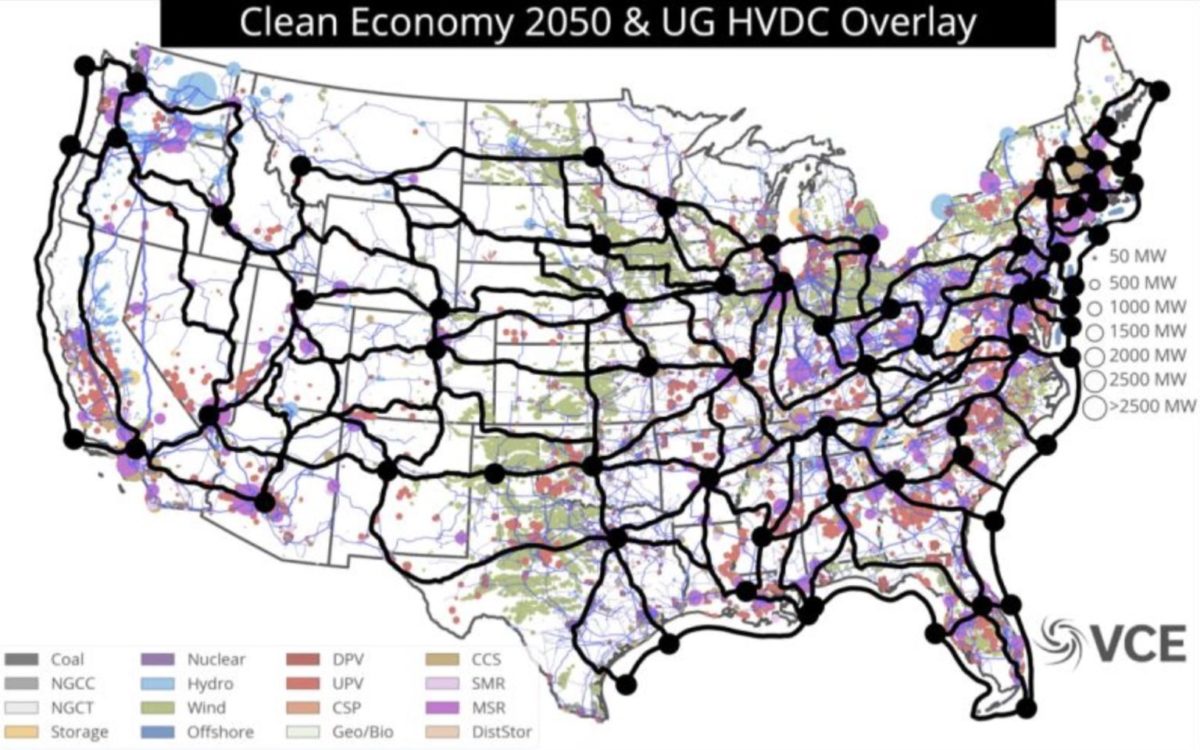From pv magazine USA
Modeling specialist Vibrant Clean Energy (VCE) has proposed a transmission “overlay” for the contiguous United States, with about 210 underground high-voltage direct current (HVDC) transmission lines, 70 nodes, and underwater lines along nearly the entire coastline. HVDC transmission can deliver power over long distances more efficiently than alternating current (AC) transmission.
“This is the system built in our zero2050usa study,” said VCE CEO Christopher Clack on LinkedIn, adding that a report describing the study will “come soon.” The study modeled a net-zero emissions economy for the contiguous United States, including an HVDC “macrogrid” built by 2025.
In the least-cost scenario, installed solar capacity would exceed 830 GW by 2050, while wind capacity would exceed 1130 GW, with onshore wind predominating. VCE modeled 10 scenarios using its WIS:dom-P model.
Previous solar and wind capacity projections from the National Renewable Energy Laboratory’s “Interconnection Seams Study” showed that HVDC could economically transmit solar power from sunnier regions to less sunny regions. However, it added that HVDC transmission would not result in more solar overall. Rather, it could lead to more solar development in sunnier regions but less solar development in other regions, leaving the total approximately unchanged.
VCE’s modeled transmission system would cost $400 billion if financed over 30 years at a 3% interest rate. That translates to a cost of $7.50/MWh, which would enable reduced electricity costs of $25/MWh. It would save 4.5 gigatons of greenhouse gas emissions by 2050. At an 8% interest rate, it would cost $700 billion. Costs were based on cost numbers from “Tier 1” vendors and construction companies likely to do the work, with some “padding” because the numbers “might be a little optimistic,” Clack said.
The US Department of Energy (DoE) is conducting a National Transmission Needs Study, and will release the draft 2023 study by year end for comment and feedback. To date, the consultation draft has been presented to Native American tribes. The DoE has identified transmission along highways and other rights of way as a research and development opportunity.
The proposed SOO Green HVDC Link transmission project will transmit wind power from Iowa eastward. It has been gaining investors and partners for a 349-mile, 2.1 GW transmission line, largely along railroad rights-of-way and entirely underground.
This content is protected by copyright and may not be reused. If you want to cooperate with us and would like to reuse some of our content, please contact: editors@pv-magazine.com.



5 comments
By submitting this form you agree to pv magazine using your data for the purposes of publishing your comment.
Your personal data will only be disclosed or otherwise transmitted to third parties for the purposes of spam filtering or if this is necessary for technical maintenance of the website. Any other transfer to third parties will not take place unless this is justified on the basis of applicable data protection regulations or if pv magazine is legally obliged to do so.
You may revoke this consent at any time with effect for the future, in which case your personal data will be deleted immediately. Otherwise, your data will be deleted if pv magazine has processed your request or the purpose of data storage is fulfilled.
Further information on data privacy can be found in our Data Protection Policy.